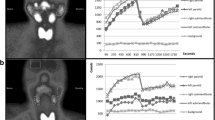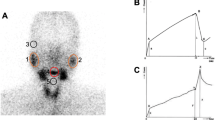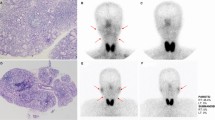Abstract
Objectives
The diagnostic validity of salivary gland scintigraphy in Sjögren’s syndrome (SS) has not been conclusively defined. Whether a quantitative (excretion fraction) interpretation of scintigraphy is superior to a qualitative one (visual analysis) remains a matter of debate. We sought to determine whether the diagnostic discrimination of excretion fraction is higher compared to that obtained by visual analysis.
Methods
Diagnostic test validity study that encompassed 137 suspected SS subjects who underwent scintigraphy for diagnostic purposes. Patients were diagnosed as SS and non-SS according to the rheumatologist’s clinical judgment, and by using the American-European Consensus Group (AECG) and American College of Rheumatology (ACR) classification criteria. Visual analysis (normal vs. abnormal and Schall’s classification grade) and excretion fraction scores were calculated. The diagnostic discrimination of these methods was compared through the area under the curve (AUC) analysis. Scintigraphy associations with SS clinical and laboratory features were assessed through multivariable regression analysis.
Results
Schall’s classification AUC reached statistical significance in its diagnostic discrimination for SS clinical judgment (0.704 [95%CI 0.597–0.811]) and AECG criteria (0.764 [95%CI 0.641–0.886]). Similarly, submandibular excretion fraction was associated with SS diagnosis based on ACR (0.737 [95%CI 0.546–0.931]) and AECG criteria (0.715 [95%CI 0.597–0.833]). However, AUC comparisons between qualitative and quantitative methods did not yield statistically significant values. Both interpretation modalities were associated with SS serological features. Moreover, excretion fraction was also associated with salivary gland biopsy.
Conclusions
SS diagnostic discrimination of excretion fraction is not superior to that obtained by qualitative visual analysis. Both qualitative and quantitative scintigraphy methods are associated with SS clinical and laboratory characteristics.

Similar content being viewed by others
Data availability
Data are available from the corresponding author on reasonable request.
References
Brito-Zerón P, Baldini C, Bootsma H, Bowman SJ, Jonsson R, Mariette X, Sivils K, Theander E, Tzioufas A, Ramos-Casals M (2016) Sjögren syndrome. Nat Rev Dis Primers 2:16047
Rischmueller M, Tieu J, Lester S (2016) Primary Sjögren’s syndrome. Best Pract Res Clin Rheumatol 30:189–220
Tanasiewicz M, Hildebrandt T, Obersztyn I (2016) Xerostomia of various etiologies: a review of the literature. Adv Clin Exp Med 25:199–206
Vinagre F, Santos MJ, Prata A, da Silva JC, Santos AI (2009) Assessment of salivary gland function in Sjögren’s syndrome: the role of salivary gland scintigraphy. Autoimmun Rev 8:672–676
Baldini C, Zabotti A, Filipovic N, Vukicevic A, Luciano N, Ferro F et al (2018) Imaging in primary Sjögren’s syndrome: the «obsolete and the new». Clin Exp Rheumatol 36(Suppl 112):215–221
Vitali C, Bombardieri S, Jonsson R, Moutsopoulos HM, Alexander EL, Carsons SE, Daniels TE, Fox PC, Fox RI, Kassan SS, Pillemer SR, Talal N, Weisman MH, European Study Group on Classification Criteria for Sjögren’s Syndrome (2002) Classification criteria for Sjögren’s syndrome: a revised version of the European criteria proposed by the American-European Consensus Group. Ann Rheum Dis 61:554–558
Vivino FB, Hermann GA (2008) Role of nuclear scintigraphy in the characterization and management of the salivary component of Sjögren’s syndrome. Rheum Dis Clin N Am 34:973–986
Cortés-Blanco A, Martínez-Lázaro R (2000) Reproducibility of the qualitative interpretation of dynamic salivary radionuclide scans with excretory stimulation. Acta Otorrinolaringol Esp 51:143–148
Dugonjić S, Stefanović D, Ethurović B, Spasić-Jokić V, Ajdinović B (2014) Evaluation of diagnostic parameters from parotid and submandibular dynamic salivary glands scintigraphy and unstimulated sialometry in Sjögren’s syndrome. Hell J Nucl Med 17:116–122
Zou Q, Jiao J, Zou M-H, Xu J-H, Pan Y-F, Chen J-N, Cheng MH, Zhang F, Zhang Y (2012) Semi-quantitative evaluation of salivary gland function in Sjögren’s syndrome using salivary gland scintigraphy. Clin Rheumatol 31:1699–1705
Aksoy T, Kiratli PO, Erbas B (2012) Correlations between histopathologic and scintigraphic parameters of salivary glands in patients with Sjögren’s syndrome. Clin Rheumatol 31:1365–1370
Nishiyama S, Miyawaki S, Yoshinaga Y (2006) A study to standardize quantitative evaluation of parotid gland scintigraphy in patients with Sjögren’s syndrome. J Rheumatol 33:2470–2474
Henriksen AM, Nossent HC (2007) Quantitative salivary gland scintigraphy can distinguish patients with primary Sjøgren’s syndrome during the evaluation of sicca symptoms. Clin Rheumatol 26:1837–1841
Booker J, Howarth D, Taylor L, Voutnis D, Sutherland D (2004) Appropriate utilization of semi-quantitative analysis in salivary scintigraphy. Nucl Med Commun 25:1203–1210
Shizukuishi K, Nagaoka S, Kinno Y, Saito M, Takahashi N, Kawamoto M, Abe A, Jin L, Inoue T (2003) Scoring analysis of salivary gland scintigraphy in patients with Sjögren’s syndrome. Ann Nucl Med 17:627–631
Adams BK, Al Attia HM, Parkar S (2003) Salivary gland scintigraphy in Sjögren’s syndrome: are quantitative indices the answer? Nucl Med Commun 24:1011–1016
Aung W, Murata Y, Ishida R, Takahashi Y, Okada N, Shibuya H (2001) Study of quantitative oral radioactivity in salivary gland scintigraphy and determination of the clinical stage of Sjögren’s syndrome. J Nucl Med 42:38–43
Shiboski SC, Shiboski CH, Criswell LA, Baer AN, Challacombe S, Lanfranchi H, Schiødt M, Umehara H, Vivino F, Zhao Y, Dong Y, Greenspan D, Heidenreich AM, Helin P, Kirkham B, Kitagawa K, Larkin G, Li M, Lietman T, Lindegaard J, McNamara N, Sack K, Shirlaw P, Sugai S, Vollenweider C, Whitcher J, Wu A, Zhang S, Zhang W, Greenspan JS, Daniels TE, Sjögren’s International Collaborative Clinical Alliance (SICCA) Research Groups (2012) American College of Rheumatology classification criteria for Sjögren’s syndrome: a data-driven, expert consensus approach in the Sjögren’s International Collaborative Clinical Alliance Cohort. Arthritis Care Res 64:475–487
Saleh J, Figueiredo MAZ, Cherubini K, Salum FG (2015) Salivary hypofunction: an update on aetiology, diagnosis and therapeutics. Arch Oral Biol 60:242–255
Han P, Suarez-Durall P, Mulligan R (2015) Dry mouth: a critical topic for older adult patients. J Prosthodont Res 59:6–19
Guevara-Gutiérrez E, Tlacuilo-Parra A, Minjares-Padilla LM (2001) Minor salivary gland punch biopsy for evaluation of Sjögren’s syndrome. J Clin Rheumatol 7:401–402
Chisholm DM, Mason DK (1968) Labial salivary gland biopsy in Sjögren’s disease. J Clin Pathol 21:656–660
Demangeat R, Didon-Poncelet A, Cherfan J, Demangeat J-L (2000) Stimulated salivary pertechnetate clearance revisited: correlation with dynamic scintigraphic indices in sicca syndrome. Clin Nucl Med 25:888–894
Schall GL, Anderson LG, Wolf RO, Herdt JR, Tarpley TM, Cummings NA et al (1971) Xerostomia in Sjögren’s syndrome. Evaluation by sequential salivary scintigraphy. JAMA 216:2109–2116
Milic VD, Petrovic RR, Boricic IV, Marinkovic-Eric J, Radunovic GL, Jeremic PD et al (2009) Diagnostic value of salivary gland ultrasonographic scoring system in primary Sjögren’s syndrome: a comparison with scintigraphy and biopsy. J Rheumatol 36:1495–1500
DeLong ER, DeLong DM, Clarke-Pearson DL (1988) Comparing the areas under two or more correlated receiver operating characteristic curves: a nonparametric approach. Biometrics 44:837–845
García-González M, Rodríguez-Lozano B, Bustabad S, Ferraz-Amaro I (2017) Undifferentiated connective tissue disease: predictors of evolution into definite disease. Clin Exp Rheumatol 35:739–745
Milic V, Petrovic R, Boricic I, Radunovic G, Marinkovic-Eric J, Jeremic P, Damjanov N (2012) Ultrasonography of major salivary glands could be an alternative tool to sialoscintigraphy in the American-European classification criteria for primary Sjogren’s syndrome. Rheumatology 51:1081–1085
Salaffi F, Carotti M, Iagnocco A, Luccioli F, Ramonda R, Sabatini E, de Nicola M, Maggi M, Priori R, Valesini G, Gerli R, Punzi L, Giuseppetti GM, Salvolini U, Grassi W (2008) Ultrasonography of salivary glands in primary Sjogren’s syndrome: a comparison with contrast sialography and scintigraphy. Rheumatology 47:1244–1249
Infante JR, García L, Rayo JI, Serrano J, Domínguez ML, Moreno M (2016) Diagnostic contribution of quantitative analysis of salivary scintigraphy in patients with suspected Sjögren’s syndrome. Rev Esp Med Nucl E Imagen Mol 35:145–151
Kaldeway HP, ter Borg E-J, van de Garde EMW, Habraken JBA, van Buul MMC (2019) Validation of quantitative salivary gland scintigraphy in relation to the American–European concensus criteria for Sjögren’s syndrome. Nucl Med Commun 40:343–348
Umehara I, Yamada I, Murata Y, Takahashi Y, Okada N, Shibuya H (1999) Quantitative evaluation of salivary gland scintigraphy in Sjörgen’s syndrome. J Nucl Med 40:64–69
Kim H-A, Yoon S-H, Yoon J-K, Lee SJ, Jo KS, Lee DH, Suh CH, An YS (2014) Salivary gland scintigraphy in Sjögren’s syndrome: comparison of the diagnostic performance of visual and semiquantitative analysis. Nuklearmedizin 53:139–145
Ferro F, Marcucci E, Orlandi M, Baldini C, Bartoloni-Bocci E (2017) One year in review 2017: primary Sjögren’s syndrome. Clin Exp Rheumatol 35:179–191
Ramos-Casals M, Brito-ZeróN P, Perez-De-Lis M, Diaz-Lagares C, Bove A, Soto M-J et al (2010) Clinical and prognostic significance of parotid scintigraphy in 405 patients with primary Sjögren’s syndrome. J Rheumatol 37:585–590
Vinagre F, Santos AI, Santos MJ, Prata A, Oliveira A, Canas da Silva JC (2008) Salivary gland scintigraphy in the evaluation of patients with sicca complaints. Acta Reumatol Port 33:422
Guellec D, Cornec D, Jousse-Joulin S, Marhadour T, Marcorelles P, Pers J-O, Saraux A, Devauchelle-Pensec V (2013) Diagnostic value of labial minor salivary gland biopsy for Sjögren’s syndrome: a systematic review. Autoimmun Rev 12:416–420
Acknowledgments
We thank the Sociedad Española de Reumatología for its assistance in the English-language review of this manuscript.
Author information
Authors and Affiliations
Contributions
M.G.G. and I.F.A. designed and performed the research, analyzed the data, and wrote the manuscript. M.J.G.S. and M.A.G.R.B. acquired the SGS images, helped interpret the data, and assisted in preparing the manuscript.
Corresponding author
Ethics declarations
Disclosures
None.
Ethics approval and consent to participate
This study was approved by the institutional review board of the Hospital Universitario de Canarias (IRB approval Number: 2014_18) and is in accordance with both the ethical standards and the Helsinki Declaration of 1975, as revised in 2013. Due to the retrospective nature of the data collection, the IRB waived informed consent.
Consent for publication
Not applicable.
Code availability
Not applicable.
Additional information
Publisher’s note
Springer Nature remains neutral with regard to jurisdictional claims in published maps and institutional affiliations.
Rights and permissions
About this article
Cite this article
García-González, M., González-Soto, M.J., Gómez Rodríguez-Bethencourt, M.Á. et al. The validity of salivary gland scintigraphy in Sjögren’s syndrome diagnosis: comparison of visual and excretion fraction analyses. Clin Rheumatol 40, 1923–1931 (2021). https://doi.org/10.1007/s10067-020-05462-0
Received:
Revised:
Accepted:
Published:
Issue Date:
DOI: https://doi.org/10.1007/s10067-020-05462-0




